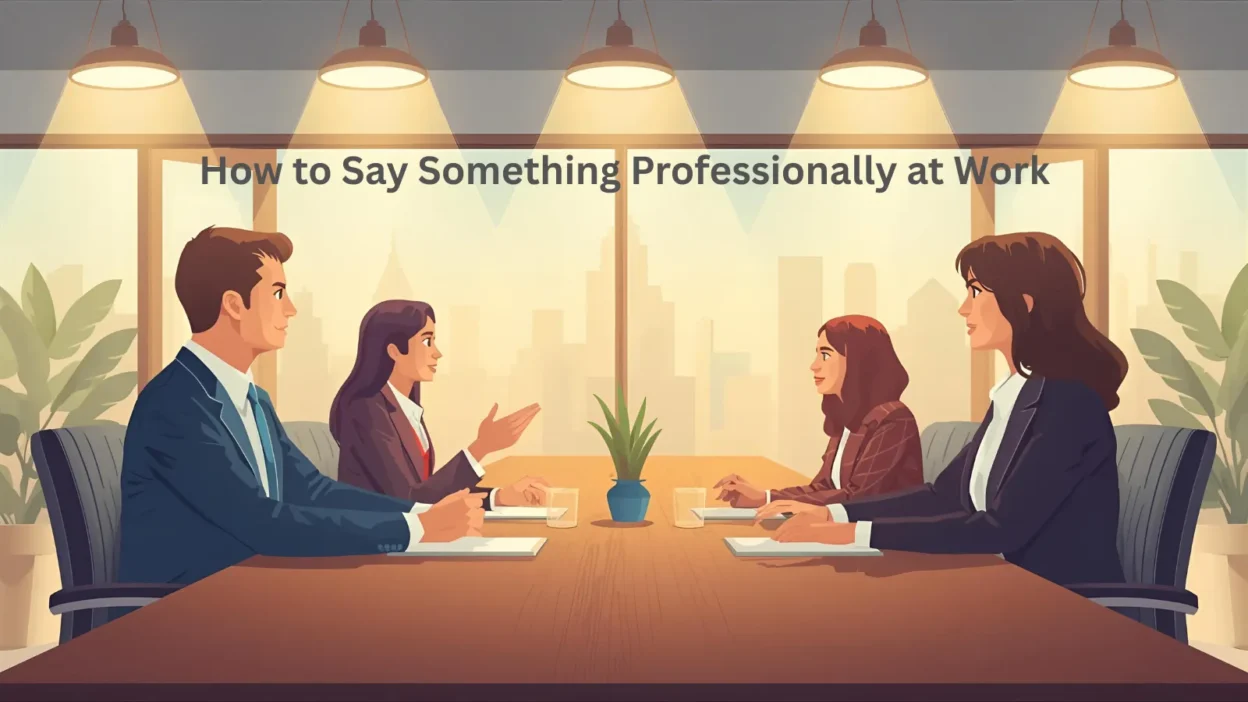Learning how to say something professionally at work is key to building respect and clear communication in the workplace. The right words help you sound confident, polite, and solution-focused while avoiding misunderstandings.
By practicing professional language, you can strengthen relationships with colleagues, impress managers, and create a positive work environment. Professional communication also boosts teamwork and reduces conflicts.
Say Something Professionally
15 Professional Workplace Phrase Alternatives
| # | Instead of Saying… | Say This Professionally… |
|---|---|---|
| 1 | That’s not my problem. | Let’s see who can best handle this situation. |
| 2 | You’re wrong. | I see it differently, let me share my perspective. |
| 3 | I don’t know. | I’ll find out and get back to you. |
| 4 | Do it now. | Could you prioritize this task today? |
| 5 | Calm down. | Let’s take a moment to regroup and discuss calmly. |
| 6 | That’s impossible. | That might be challenging, but let’s explore options. |
| 7 | I already said that. | As I mentioned earlier, here’s what we discussed. |
| 8 | That’s not my job. | I may not handle this directly, but let me guide you. |
| 9 | You don’t understand. | Let me explain it another way for clarity. |
| 10 | That’s a bad idea. | I see some risks, but maybe we can adjust the plan. |
| 11 | You need to do better. | Here are a few suggestions to improve next time. |
| 12 | I’m too busy. | My schedule is full, but I can assist after this time. |
| 13 | That makes no sense. | Could you clarify so we’re on the same page? |
| 14 | You’re late again. | I noticed delays—let’s work on staying on schedule. |
| 15 | That’s not good enough. | Let’s refine this to meet the expectations. |
In this guide, you’ll learn 15 ways to professionally say common things, complete with real-life dialogues and helpful context so you always sound polished.
1. Instead of “I don’t know” → “Let me look into that and get back to you.”

Origin/Use:
Used in corporate and formal communication to show accountability rather than ignorance.
Example:
👤 User A: Do you know why the client meeting was moved?
👤 User B: Let me look into that and get back to you shortly.
2. Instead of “No” → “Unfortunately, I’m unable to…”
Origin/Use:
Softens rejection and adds professionalism, especially useful in customer service or when declining politely.
Example:
👤 User A: Can you attend the client call at 5 PM?
👤 User B: Unfortunately, I’m unable to make it at that time.
3. Instead of “Okay” → “That sounds good to me.”
Origin/Use:
More confident and agreeable than a casual “Okay”; used to confirm plans or agreements professionally.
Example:
👤 User A: I’ll send over the proposal by tomorrow morning.
👤 User B: That sounds good to me. Looking forward to it.
4. Instead of “You messed up” → “There seems to have been a misunderstanding.”

Origin/Use:
A diplomatic way to bring up mistakes without assigning direct blame.
Example:
👤 User A: Why did the file go to the wrong client?
👤 User B: There seems to have been a misunderstanding—I’ll take care of it right away.
5. Instead of “I want” → “I would appreciate if…”
Origin/Use:
Adds politeness to requests and softens your tone.
Example:
👤 User A: Can you fix this quickly?
👤 User B: I would appreciate it if we could prioritize this issue.
6. Instead of “Hurry up” → “Can we aim to complete this by…”
Origin/Use:
Keeps urgency professional without sounding demanding.
Example:
👤 User A: This task is taking too long.
👤 User B: Can we aim to complete this by the end of the day?
7. Instead of “That’s not my job” → “Let me check who handles that.”

Origin/Use:
A more collaborative, team-oriented response.
Example:
👤 User A: Can you upload the financials?
👤 User B: Let me check who handles that and get back to you.
8. Instead of “Whatever” → “I’ll leave the final decision up to you.”
Origin/Use:
Shows respect for authority or team consensus.
Example:
👤 User A: Should we go with Plan A or B?
👤 User B: I’ll leave the final decision up to you.
9. Instead of “I don’t care” → “I’m open to either option.”
Origin/Use:
Keeps a neutral tone while inviting collaboration.
Example:
👤 User A: Should we meet at 2 or 3 PM?
👤 User B: I’m open to either option—whichever works best for the team.
10. Instead of “This is wrong” → “Let’s revisit this part.”
Origin/Use:
Tactful way to suggest corrections without offending.
Example:
👤 User A: Here’s the final design.
👤 User B: Thanks! Let’s revisit this part to align with the brief.
11. Instead of “Calm down” → “Let’s take a moment to regroup.”
Origin/Use:
Professional tone especially useful during tense or emotional meetings.
Example:
👤 User A: This is so frustrating!
👤 User B: I understand—let’s take a moment to regroup.
12. Instead of “You should have…” → “In the future, we might consider…”
Origin/Use:
Turns criticism into constructive feedback.
Example:
👤 User A: You didn’t CC the client.
👤 User B: In the future, we might consider including the client on those emails.
13. Instead of “Send it ASAP” → “Please prioritize this.”
Origin/Use:
Shows urgency without pressure.
Example:
👤 User A: When do you need this by?
👤 User B: If possible, please prioritize this today.
14. Instead of “I’m busy” → “I’m currently tied up, but I’ll follow up shortly.”
Origin/Use:
Keeps professionalism intact while setting boundaries.
Example:
👤 User A: Can we discuss this now?
👤 User B: I’m currently tied up, but I’ll follow up shortly.
15. Instead of “This makes no sense” → “Could you help clarify this section?”
Origin/Use:
Invites collaboration and maintains respectful tone.
Example:
👤 User A: What do you think of this slide?
👤 User B: Could you help clarify this section? I want to ensure I understand it fully.
Conclusion:
Mastering how to say something professionally at work helps you stand out as respectful, clear, and confident. By choosing polished alternatives instead of casual or blunt words, you’ll improve communication, strengthen professional relationships, and create a positive impression in any workplace setting.



